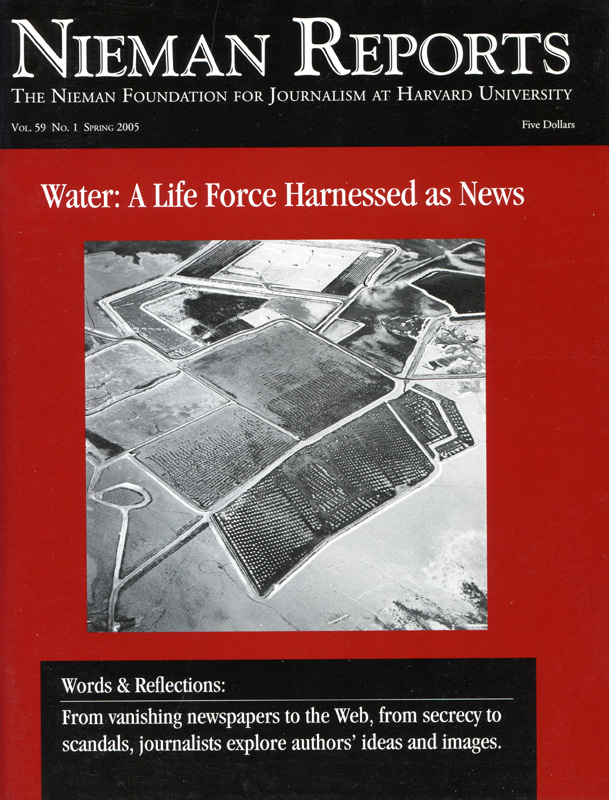After seeing some online videos I did for an independent study project to complete my masters in documentary filmmaking, Carol Hanner, the project editor for “Dividing the Waters,” suggested I produce a video for our Web site about Rocky Ford. Because of my role as the project’s photo editor, I’d already begun to get a sense of the story and place from photographer Marc Piscotty’s images, as he and I would meet to choose photographs and discuss the story’s progress.
My goal would be to amplify aspects of Todd Hartman’s narrative in two short-form documentary videos. While our Denver-area readers might know the suburb of Aurora, my video would transport them with sound and motion to the rural town of Rocky Ford.
I spent two days videotaping in Rocky Ford. For one piece, I rode with the ditch rider who checks the 13-mile Rocky Ford canal twice a day to read water levels and makes sure it’s fl owing smoothly. Although he was a minor character in Todd’s story, it was a good visual way to show the ditch and its path through the town. The second two-minute video began with a local museum curator giving a brief historical overview, combined with archive photographs and my footage of the town. The curator told the story of Rocky Ford’s beginnings as the watermelon capital of the nation. The last half of the video showed a fourthgeneration Rocky Ford farmer using a water irrigation system. The sound of fl owing water and the trickle of water through the furrows of the sorghum fi eld were the heart of this piece, as well as the farmer’s understanding of his neighbors’ decisions to sell their water rights. He was also mentioned in Todd’s story.
In addition to these two videos, the presentation by my Web site colleagues, Tim Skillern and Becki Dilfer, was multifaceted. It included animated maps of the Arkansas River, a slide show of Aurora, and an interview with an Aurora water offi cial who was a main character in Todd’s story. For a “making of the story” segment, Tim interviewed both Todd and Marc, the story’s reporter and photographer.
For the digital newsbook, Roger Fidler reworked several of these elements, including using only the audio of the ditch rider from my original video and re-editing the videos into two shorter pieces.
Sonya Doctorian produces “Video Journal,” a series of video essays for the Rocky Mountain News Web site. She also works with the newspaper’s photography staff as a coach and project photo editor.
My goal would be to amplify aspects of Todd Hartman’s narrative in two short-form documentary videos. While our Denver-area readers might know the suburb of Aurora, my video would transport them with sound and motion to the rural town of Rocky Ford.
I spent two days videotaping in Rocky Ford. For one piece, I rode with the ditch rider who checks the 13-mile Rocky Ford canal twice a day to read water levels and makes sure it’s fl owing smoothly. Although he was a minor character in Todd’s story, it was a good visual way to show the ditch and its path through the town. The second two-minute video began with a local museum curator giving a brief historical overview, combined with archive photographs and my footage of the town. The curator told the story of Rocky Ford’s beginnings as the watermelon capital of the nation. The last half of the video showed a fourthgeneration Rocky Ford farmer using a water irrigation system. The sound of fl owing water and the trickle of water through the furrows of the sorghum fi eld were the heart of this piece, as well as the farmer’s understanding of his neighbors’ decisions to sell their water rights. He was also mentioned in Todd’s story.
In addition to these two videos, the presentation by my Web site colleagues, Tim Skillern and Becki Dilfer, was multifaceted. It included animated maps of the Arkansas River, a slide show of Aurora, and an interview with an Aurora water offi cial who was a main character in Todd’s story. For a “making of the story” segment, Tim interviewed both Todd and Marc, the story’s reporter and photographer.
For the digital newsbook, Roger Fidler reworked several of these elements, including using only the audio of the ditch rider from my original video and re-editing the videos into two shorter pieces.
Sonya Doctorian produces “Video Journal,” a series of video essays for the Rocky Mountain News Web site. She also works with the newspaper’s photography staff as a coach and project photo editor.



